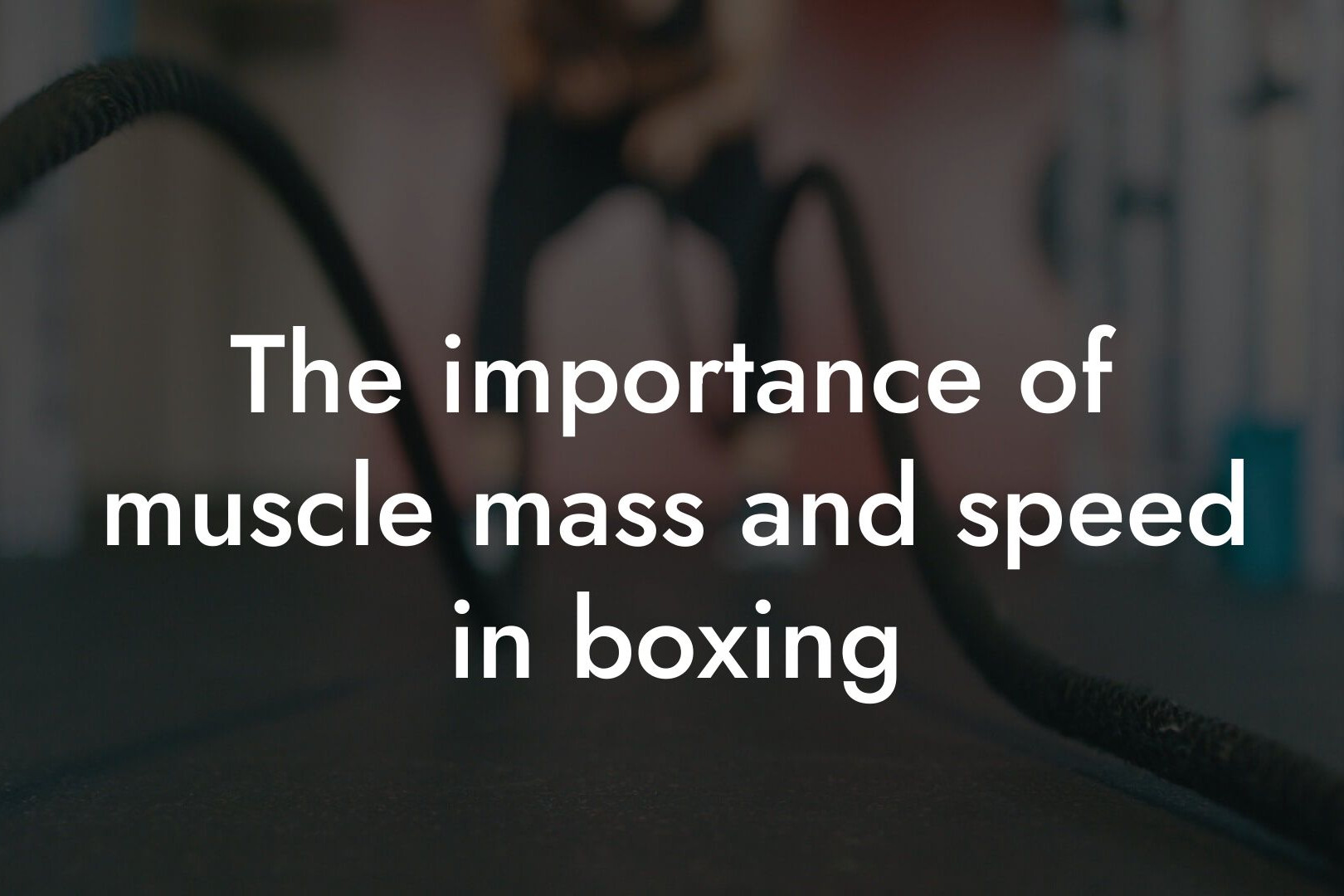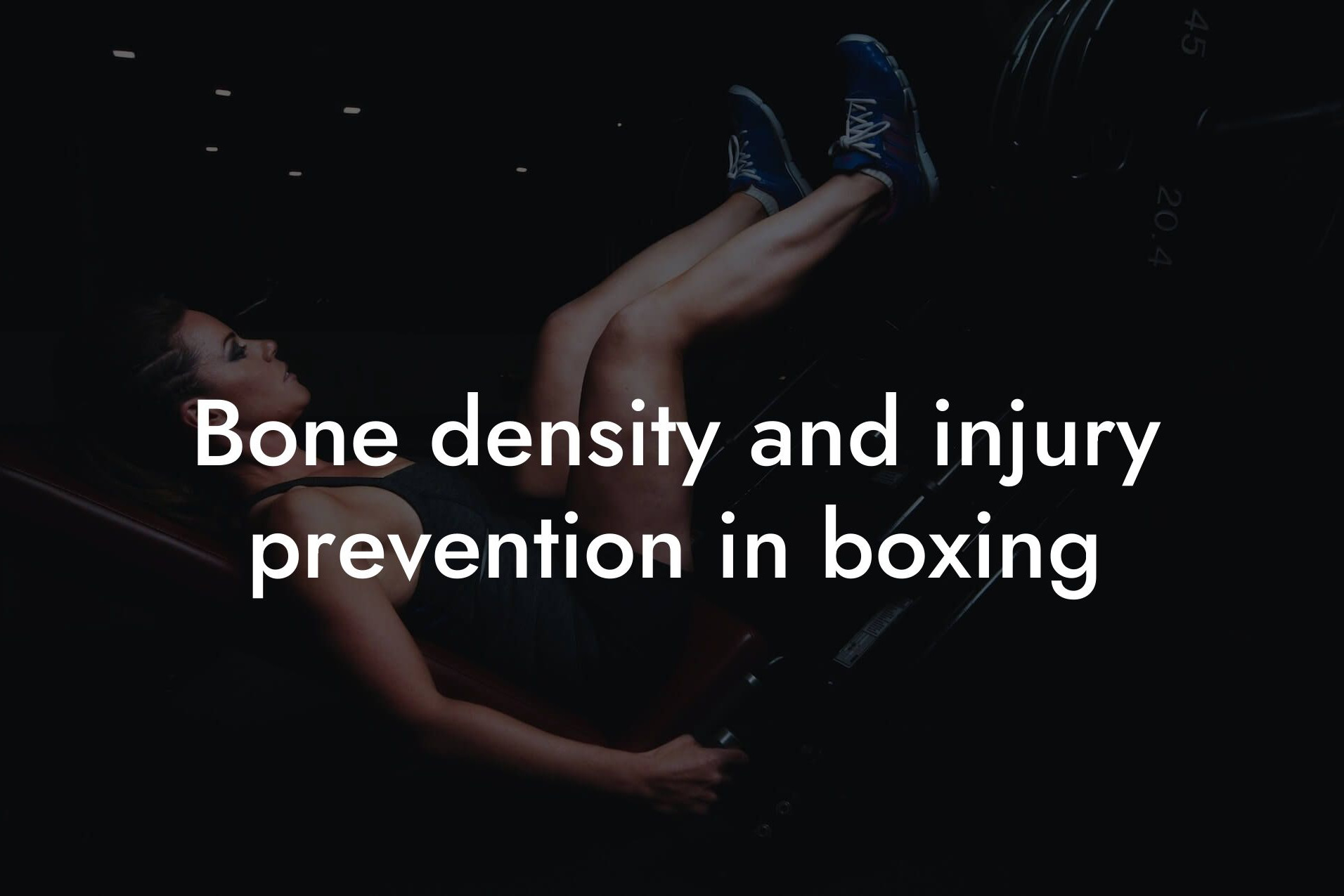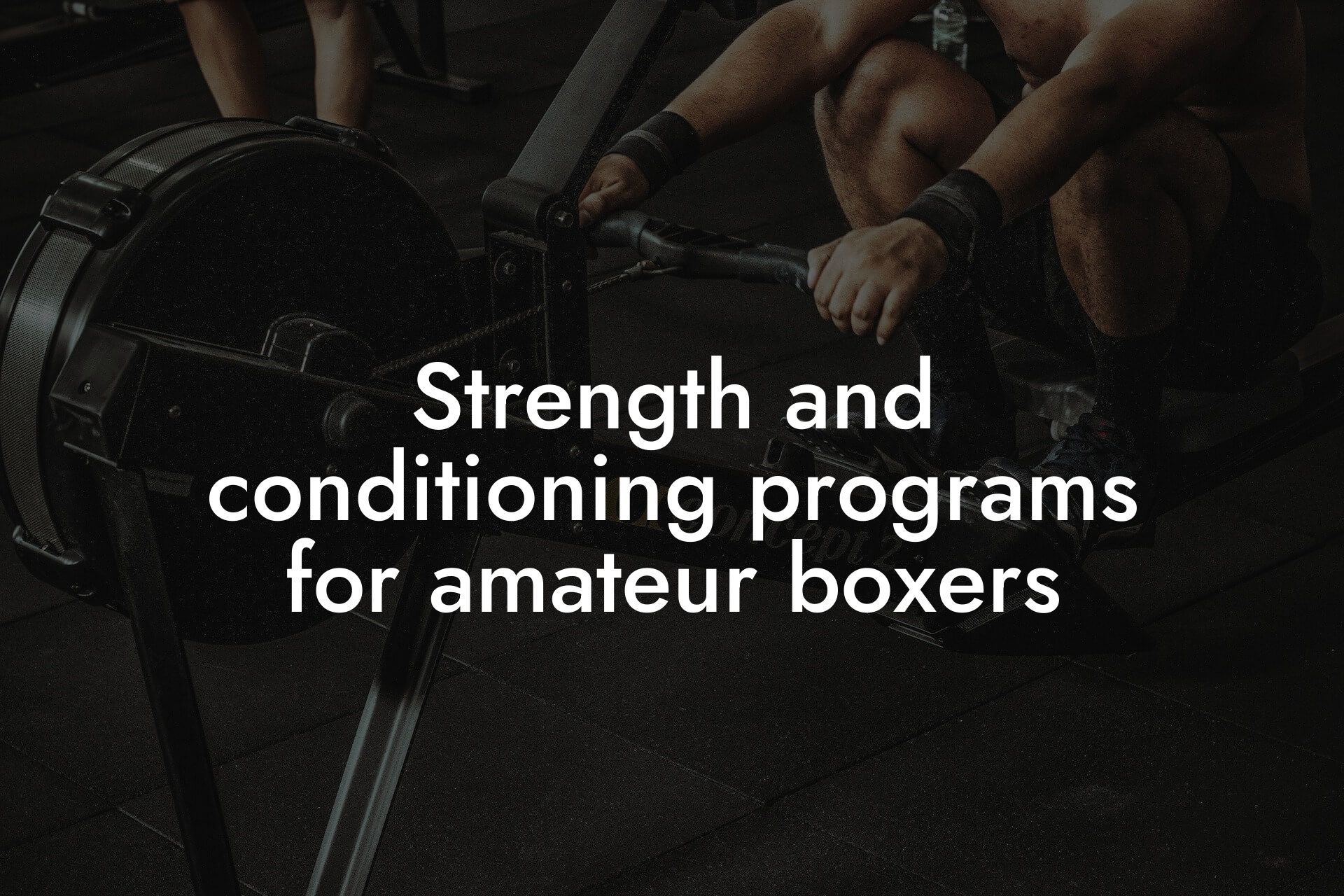As a high-earning professional, you understand the importance of maintaining a strong physical appearance and physique. Boxing is an excellent way to improve your overall fitness, build confidence, and relieve stress. However, to excel in the ring, you need to balance three essential components: power, speed, and endurance. In this article, we'll delve into the world of boxing and provide you with a comprehensive guide on how to achieve the perfect balance between these three crucial elements.
Table of Contents
- Understanding Power in Boxing
- The Importance of Speed in Boxing
- Building Endurance in Boxing
- The Relationship Between Power, Speed, and Endurance
- Training Strategies for Balancing Power, Speed, and Endurance
- Nutrition and Recovery for Optimal Performance
- Body Composition and Boxing Performance
- Frequently Asked Questions
Understanding Power in Boxing
Power is the ability to generate maximum force in a short amount of time. In boxing, power is essential for landing knockout blows and dominating your opponent. To develop power, you need to focus on building your muscular strength, particularly in your upper body. This can be achieved through exercises such as push-ups, pull-ups, and weightlifting. Additionally, plyometric exercises like jump squats and box jumps can help improve your explosiveness.
The Importance of Speed in Boxing
Speed is the ability to move quickly and efficiently around the ring. A fast boxer can evade their opponent's attacks, create angles, and land quick combinations. To improve your speed, you need to work on your footwork, hand speed, and reaction time. Agility drills, such as ladder runs and cone drills, can help increase your speed and quickness. Additionally, incorporating hand speed exercises like focus mitts and speed bags into your training can help you develop lightning-fast reflexes.
Building Endurance in Boxing
Endurance is the ability to maintain a high level of intensity over a prolonged period. In boxing, endurance is crucial for lasting the full 12 rounds and outlasting your opponent. To build endurance, you need to focus on cardiovascular exercises like running, jumping rope, and cycling. High-intensity interval training (HIIT) is also an effective way to improve your endurance, as it simulates the intense bursts of energy required in a boxing match.
The Relationship Between Power, Speed, and Endurance
Power, speed, and endurance are interconnected components that rely on each other to achieve success in boxing. A powerful boxer needs to be able to generate speed to land effective combinations, while a fast boxer needs to have the endurance to maintain their pace throughout the fight. A well-rounded boxer needs to strike a balance between these three elements to be effective in the ring.
Training Strategies for Balancing Power, Speed, and Endurance
To balance power, speed, and endurance, you need to incorporate a variety of training strategies into your workout routine. Here are a few effective methods:
1. Periodization: Divide your training into specific periods, focusing on one component at a time. For example, you may dedicate one month to building power, followed by a month of speed training, and finally a month of endurance training.
2. Concurrent Training: Incorporate exercises that target multiple components simultaneously. For example, a plyometric exercise like box jumps can improve both power and speed.
3. High-Intensity Interval Training (HIIT): Incorporate HIIT into your workout routine to improve your endurance and increase your anaerobic capacity.
Nutrition and Recovery for Optimal Performance
A well-balanced diet and effective recovery strategies are crucial for optimal performance in boxing. A diet rich in protein, complex carbohydrates, and healthy fats can help support muscle growth and repair. Additionally, staying hydrated by drinking plenty of water is essential for maintaining energy levels and preventing dehydration.
In terms of recovery, incorporating techniques like foam rolling, stretching, and massage can help reduce muscle soreness and improve flexibility. Adequate sleep and rest are also essential for allowing your body to recover and adapt to the demands of boxing training.
Body Composition and Boxing Performance
As a high-earning professional, you understand the importance of maintaining a healthy body composition. In boxing, a lean and athletic physique can improve your performance and increase your chances of success. A DEXA scan can provide you with a detailed analysis of your body composition, including your bone density, muscle mass, and body fat percentage. This information can help you tailor your training and nutrition plan to optimize your performance in the ring.
Balancing power, speed, and endurance is crucial for success in boxing. By understanding the importance of each component, incorporating effective training strategies, and prioritizing nutrition and recovery, you can optimize your performance and achieve your goals in the ring. Remember, a well-rounded boxer is a formidable opponent, and with the right training and mindset, you can dominate the competition.
Frequently Asked Questions
What is the importance of balancing power, speed, and endurance in boxing?
Balancing power, speed, and endurance is crucial in boxing as it allows fighters to perform at their optimal level. Power enables fighters to deliver devastating blows, speed allows them to evade and land quick combinations, and endurance ensures they can maintain their pace throughout the fight. A balanced approach helps fighters to conserve energy, increase their chances of winning, and reduce the risk of injury.
How do I improve my power in boxing?
To improve your power in boxing, focus on building your strength through weightlifting exercises such as squats, deadlifts, and bench press. Additionally, incorporate plyometric exercises like box jumps and medicine ball throws to increase your explosive power. Proper technique and footwork are also essential in generating power in your punches.
What are some effective ways to increase my speed in boxing?
To increase your speed in boxing, incorporate high-intensity interval training (HIIT) into your workout routine. This involves short bursts of intense exercise followed by brief periods of rest. Agility drills, such as ladder drills and cone drills, can also help improve your hand speed and footwork. Furthermore, focus on your hand-eye coordination through exercises like focus mitts and heavy bag work.
How can I improve my endurance in boxing?
To improve your endurance in boxing, engage in cardiovascular exercises such as running, jumping rope, or cycling. High-intensity interval training (HIIT) can also help improve your anaerobic endurance. Incorporate strength training exercises that target your core and legs, as these are essential for maintaining your stamina throughout a fight. Additionally, practice your technique and sparring to build your endurance in a live fighting scenario.
What is the ideal balance between power, speed, and endurance in boxing?
The ideal balance between power, speed, and endurance in boxing varies depending on the individual fighter's style and goals. However, a general rule of thumb is to allocate 30% of your training to power development, 30% to speed and agility, and 40% to endurance and conditioning. This balance allows fighters to maintain their power and speed while having the endurance to sustain themselves throughout a fight.
How can I incorporate strength training into my boxing routine?
Incorporate strength training into your boxing routine by focusing on exercises that target your core, legs, and upper body. Squats, deadlifts, and bench press are essential exercises for building overall strength. Additionally, incorporate plyometric exercises like box jumps and medicine ball throws to improve your explosive power. Aim to strength train 2-3 times a week, with at least one day of rest in between.
What is the importance of plyometric training in boxing?
Plyometric training is essential in boxing as it helps improve explosive power, speed, and agility. Plyometric exercises, such as box jumps and medicine ball throws, simulate the rapid contractions and relaxations of muscles that occur during a boxing match. This type of training enables fighters to generate more power in their punches and move quickly around the ring.
How can I improve my hand-eye coordination in boxing?
To improve your hand-eye coordination in boxing, incorporate exercises that challenge your reaction time and spatial awareness. Focus mitts, heavy bag work, and double-end bag training are effective ways to improve your hand-eye coordination. Additionally, engage in reaction drills, such as catching punches or reacting to visual cues, to further enhance your coordination.
What is the role of agility training in boxing?
Agility training plays a crucial role in boxing as it enables fighters to quickly change direction, evade punches, and create angles. Agility drills, such as ladder drills and cone drills, improve a fighter's speed, reaction time, and overall ring generalship. Incorporate agility training into your routine 2-3 times a week to see significant improvements in your boxing performance.
How can I incorporate conditioning exercises into my boxing routine?
Incorporate conditioning exercises into your boxing routine by engaging in high-intensity interval training (HIIT) and strength training exercises that target your core and legs. Additionally, incorporate cardio exercises like running, jumping rope, or cycling to improve your anaerobic endurance. Aim to condition 3-4 times a week, with at least one day of rest in between.
What is the importance of footwork in boxing?
Footwork is essential in boxing as it enables fighters to move efficiently around the ring, evade punches, and create angles. Good footwork allows fighters to conserve energy, generate power in their punches, and maintain their balance and coordination. Focus on proper footwork technique, including shuffling, bobbing, and weaving, to improve your overall boxing performance.
How can I improve my punching technique in boxing?
To improve your punching technique in boxing, focus on proper hand positioning, wrist rotation, and body rotation. Practice punching with a heavy bag, focus mitts, or a partner to develop your technique. Additionally, incorporate strength training exercises that target your shoulders, back, and core to generate more power in your punches.
What is the role of core strength in boxing?
Core strength plays a crucial role in boxing as it enables fighters to generate power, maintain their balance, and absorb punches. A strong core helps fighters to rotate their body, generate torque, and deliver devastating blows. Incorporate exercises like planks, Russian twists, and leg raises into your strength training routine to improve your core strength.
How can I improve my defense in boxing?
To improve your defense in boxing, focus on proper head movement, footwork, and hand positioning. Practice slipping, bobbing, and weaving to evade punches, and incorporate defense drills into your training routine. Additionally, focus on building your endurance and conditioning to maintain your defense throughout a fight.
What is the importance of sparring in boxing?
Sparring is essential in boxing as it allows fighters to apply their skills in a live fighting scenario. Sparring helps fighters to develop their reflexes, timing, and strategy, and enables them to adapt to different fighting styles and opponents. Incorporate sparring into your training routine 1-2 times a week to see significant improvements in your boxing performance.
How can I balance my boxing training with other aspects of my life?
To balance your boxing training with other aspects of your life, create a schedule that allows for dedicated time for training, rest, and recovery. Prioritize your training sessions, and make time for other activities, such as work, family, and socializing. Additionally, focus on your nutrition and recovery strategies to ensure you're fueling your body for optimal performance.
What is the importance of nutrition in boxing?
Nutrition plays a critical role in boxing as it enables fighters to fuel their bodies for optimal performance. A balanced diet that includes protein, complex carbohydrates, and healthy fats helps fighters to build strength, endurance, and speed. Additionally, proper nutrition helps fighters to recover quickly from intense training sessions and fights.
How can I recover from a boxing match?
To recover from a boxing match, focus on proper nutrition, hydration, and rest. Consume a balanced meal or snack that includes protein and complex carbohydrates within 30-60 minutes after the fight. Additionally, engage in light stretching and foam rolling to reduce muscle soreness, and prioritize rest and recovery for at least 24-48 hours after the fight.
What is the role of mental preparation in boxing?
Mental preparation plays a crucial role in boxing as it enables fighters to develop a winning mindset, overcome fear and anxiety, and stay focused under pressure. Incorporate mental training techniques, such as visualization, positive self-talk, and breathing exercises, into your training routine to improve your mental toughness and resilience.
How can I stay motivated in my boxing training?
To stay motivated in your boxing training, set specific, measurable, and achievable goals for yourself. Celebrate your progress and accomplishments, and find a training partner or coach who can provide support and guidance. Additionally, focus on your why – the reason you started boxing in the first place – to stay motivated and driven.
What is the importance of proper warm-up and cool-down in boxing?
Proper warm-up and cool-down are essential in boxing as they help prevent injuries, improve performance, and enhance recovery. A dynamic warm-up prepares your muscles for intense activity, while a cool-down helps to reduce muscle soreness and improve flexibility. Incorporate exercises like jumping jacks, leg swings, and arm circles into your warm-up and cool-down routine.
How can I incorporate stretching and foam rolling into my boxing routine?
Incorporate stretching and foam rolling into your boxing routine by dedicating 10-15 minutes after each training session to static stretches and foam rolling exercises. Focus on stretching your major muscle groups, including your legs, hips, and shoulders, and use foam rolling to reduce muscle soreness and improve recovery.
What is the role of rest and recovery in boxing?
Rest and recovery play a critical role in boxing as they enable fighters to repair and adapt to the physical demands of training and fighting. Adequate rest and recovery help fighters to rebuild their energy stores, repair damaged tissues, and come back stronger and more resilient. Prioritize rest and recovery in your training routine to optimize your performance.
How can I prevent injuries in boxing?
To prevent injuries in boxing, focus on proper technique, warm-up, and cool-down. Incorporate strength training exercises that target your core, legs, and upper body to improve your overall strength and resilience. Additionally, listen to your body and take regular breaks to rest and recover. Prioritize your safety and well-being above all else.
Here are some related articles you might love...
- The importance of muscle mass and speed in boxing
- Bone density and injury prevention in boxing
- Strength and conditioning programs for amateur boxers
- Reducing body fat for optimal weight class in boxing
- Nutrition tips for maintaining energy and muscle in boxing
- How body composition affects performance in boxing
- Off-season training for amateur boxers
- Recovery strategies for boxers after sparring sessions
- The role of DEXA scans in boxing training and weight management
Zak Faulkner
Zak Faulkner is a leading authority in the realm of physical health and body composition analysis, with over 15 years of experience helping professionals optimise their fitness and well-being. As one the experts behind Tano Performance Group, Zak has dedicated his career to providing in-depth, science-backed insights that empower clients to elevate their physical performance and overall health.
With extensive knowledge of DEXA technology, Zak specializes in delivering comprehensive body assessments that offer precise data on body fat, muscle mass, bone density, and overall physique. His expertise enables individuals to make informed decisions and achieve their fitness goals with accuracy and confidence. Zak’s approach is rooted in a deep understanding of human physiology, combined with a passion for helping clients unlock their full potential through personalised strategies.
Over the years, Zak has earned a reputation for his commitment to excellence, precision, and client-focused service. His guidance is trusted by top professionals who demand the best when it comes to their health. Whether advising on fitness programs, nutritional strategies, or long-term wellness plans, Zak Faulkner’s insights are a valuable resource for anyone serious about taking their health and fitness to the next level.
At Tano Performance Group, Zak continues to lead our Content Team revolutionising how professionals approach their physical health, offering unparalleled expertise that drives real results.




